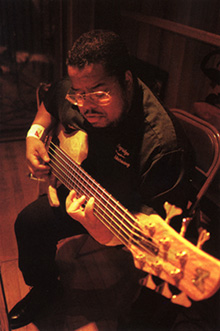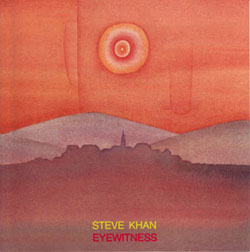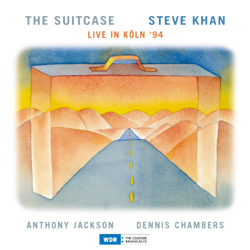

|
Soundclip:
|
| See Steve's Hand-Written Lead
Sheet |
|
Steve
Khan's
lead
sheet :  should be! How well I remember when I took home the rehearsal CSTEs from
those early sessions, and would then pour over them in the privacy of
my apartment. When I located this piece, and realized that we really
had something unique happening, I was still hesitant about actually writing
it all out. And, I never actually made a lead sheet until after "EYEWITNESS" had been recorded in November of that same year, and that was only for copyright purposes. should be! How well I remember when I took home the rehearsal CSTEs from
those early sessions, and would then pour over them in the privacy of
my apartment. When I located this piece, and realized that we really
had something unique happening, I was still hesitant about actually writing
it all out. And, I never actually made a lead sheet until after "EYEWITNESS" had been recorded in November of that same year, and that was only for copyright purposes.This particular lead sheet is really unique when compared with those which have been presented here before. It is really offered as a means of clarifying, as best as I can, the 'mysteries' of the rhythmic component of the piece. Over the years, many great musicians, listeners, have speculated as to just what is going on with this piece. Is it in an odd meter? Well, the answer is, "No!" The truth is that there are two differing concepts, neither discussed, as to just what is going on, and just where 'beat 1' really exists. If I had known then, what I now know about Latin music, and the art of the bass 'tumbao,' I am fairly certain that I would have better 'understood' just what Anthony Jackson had created. But then, I just played by 'instinct' and paid no attention to any of the technical musical details. I only knew that I heard '1' where Anthony heard beat '4.' And Steve Jordan was flexible enough to turn around his 'groove' and play it where I heard it. During the [I] section, which on the recording begins as "fade in," Steve Jordan begins by playing what you now see in Figure 1. His unique cowbell pattern is of his own invention, and has little to do with any of the traditional 4/4 bell patterns from the great Afro-Cuban tradition. For those of you who are Latin musicians, especially timbaleros, I would encourage you to try and free yourself of those 'traditions' and investigate the imagination of a great, great drummer, and learn this pattern to incorporate into your own music!!! As you can see, he is playing his kick drum on beats 2 and 4 and hitting his crash cymbal on beat 2 in the first bar of a two-bar pattern. When Anthony enters, seen in Fig. 2, his concept of the figure is obvious, and his low 'E' clearly falls on beat 4, at least to HIM!!! However, Steve Jordan knows that I was hearing Anthony's bass tumbao with that low 'E' on beat 1. And so, as we arrive at [I2], as seen in Fig. 3, Steve has shifted the center of the groove over by one beat so that, when I enter with the melody at [A], everything will line-up correctly. At least as I was hearing it. When we hit the first break at bar 16 of [A], the "game" begins! I guess one could say that you are observing two of the most stubborn musicians at work in this "game," because at [A2], Anthony moves his figure back to where it was, where he always felt it should be. For my part, knowing that he was not going to play it as I heard it, I simply dropped a beat in the 2nd bar, making it a 3/4 bar, and suddenly the figure has been turned around and is on the 'side' of the beat where I felt more comfortable. And, bless his heart, Steve Jordan helps me out and goes with me!!! The little "game" continues after each break. You see this happening again in the 2nd bar of [B]; and it will happen again as we hit letter [E] for the drum solo section. However, in live performances, over the years, for these sections, I can actually play my little figures on either side of the beat, which probably only adds to the confusion and the gamesmanship. From a harmonic perspective, it is essential to look at the notes contained within Anthony's tumbao. Except for 'A'-natural, Anthony plays the notes from E Mixolydian(E, D, G#, C#, F#, B). Well, all of that would seem to make perfect sense. However, when you look at the [A] melody as played by the guitar, it would seem that NOTHING makes any sense. How many times is, what would seem to be, a terrible note like Eb/D#, the major 7th as related to E Mixolydian(E7), played? It is there in Bars: 2; 3; 6; 7; 9-16. Then, there's the chordal sonority played in bars: 10; 12; 14; and 16, it has that Eb on top and I tend to think of that voicing as an Eb13b9 sound, and certainly part of any number of diminished sound cycles. However, none are connected to any E7(alt.) sounds because of the inclusion of Ebs(major 7th) and 'A's(sus). And yet, all this cerebral nonsense is somehow negated by the fact that "it sounded good" to us! As we arrive at [B], the harmonic mysteries continue. Anthony's bass tumbao remains exactly the same. It is still a most consonant sounding line. The first chord I play does have two notes which appear in Anthony's line: Ab/G# and Db/C#. But then there are two notes which would seem to 'rub' against the bass line: C-natural(#5) and F-natural(b9). There are those who might label this sonority as Db major 7, but here I have chosen to called in Bbm7/E. The 2nd sonority again has two notes which appear in Anthony's line: E-natural and Db/C#. However, G-natural(#9) and C-natural(#5) do not appear in the bass. I have chosen to label this sonority as C7(b9)/E. In bars 7-8 of [B] and 7-8 of [B2] there is a sense of 'resolution' as an E7(13b9) appears first, and then an E7(13, 9b5). At [C], as we transition back to [A3], again the Eb13b9 sonority is employed in parallel and in sequence, but the points-of-emphasis fall strangely, often with the inclusion of Eb/D# in the voicing. Why should this work? How can it sound good? Well, perhaps it's just not worth expending so much energy trying to figure it out and to just conclude that the sonorities are perhaps more "soundshapes"  than they are anything to do with chordal sounds which conform to structures we know. I've thought about this a great deal, because I am constantly asked about this aspect of this tune, and this is the best response I can offer. than they are anything to do with chordal sounds which conform to structures we know. I've thought about this a great deal, because I am constantly asked about this aspect of this tune, and this is the best response I can offer.Though I don't know exactly who it was, someone once said: "If you can play a standard and make it sound like a "free" tune; and if you can play a "free" piece and make it sound as though it has "changes" then you have really got somethin' goin'!!!" So, since '81 and the release of "EYEWITNESS," I've had countless letters and now e-mails asking me, "What are the solo changes to......." tunes like this. Of course, the truth is that there are none, officially speaking. I suppose one could say that 'E' is our tonal center, but that doesn't always hold true. Anthony and I never had any formal discussions about what was to happen. However, our instincts in this regard are similar. We both know that we have his fundamental bass tumbao to lean upon, to come back to, and to drift away from. And, there is a goodly amount of melodic material upon which to draw as well. And so, the solo section can go virtually anyplace, but, eventually the bass line must return, and the piece must move forward. From this point forward, the lead sheet might not agree with the recorded version. Once again, years of live playing have contributed, and in a most positive way, to giving the piece more shape and direction. It makes much greater sense to now play what is written at [D2] as we D.S. back to Pg. 2, and 8 bars before playing [B] again. Over the many years that have passed since 1981, I have been asked about the sound that I used on this tune and the "EYEWITNESS" album in general. The fundamental guiding principle for me, after the Columbia years(1977-1979) was to go back to a more pure and simple guitar sound. In essence, that was to be a Gibson ES-335 guitar played direct into an amp, and with a little reverb for treatment. As the music for this particular album developed, it just seemed that certain sections needed a little something extra, and so, on this album, that sound was produced with the help of the BOSS Flanger(BF-2). It was a rather primitive sounding effect in mono, but people seemed to respond to it. If you read below about the performance of "Where's Mumphrey?" on the "THE SUITCASE" from 1994, the major sonic difference is that then I had graduated to what became my true sonic voice, where effects are concerned, the Ibanez Digital Chorus/Flanger(DCF-10) which I have written about extensively at the EQUIPMENT page here. How well I remember some of my discussions with Joe Zawinul after having joined Weather Update, and his saying that, in the context of the music of "Weather Report," one is "always soloing" and yet, "never soloing." What an existential way to make music. Wasn't this exactly what Ornette Coleman was doing with his music? I suppose that this is what we were doing in Eyewitness too because, for example, when "Where's Mumphrey?" arrives at the [E] sections, people tend to get confused as to just what is going on. Again, I can only offer my best explanation, and hope that it will suffice. Anthony Jackson does not like to play 'traditional solos' and so, as a group, we try to create environments whereby he can be in 'conversation' with the drums and percussion. And, though the guitar, and a sense of harmony are present, it plays more of a background role. So, one could say that [E] is a "drum solo," but I've always viewed it as an "open dialogue" between the bass and drums. As for the title of this tune, well, it seemed to reveal itself to us at a rehearsal, which took place as the New York Yankees were about to play the Los Angeles Dodgers in Game #3 of the 1981 World Series, with the Yankees leading in games 2-0. Suddenly, there was a change in the Yankees' starting line-up, and outfielder Jerry Mumphrey had been removed. At that precise moment, and in perfect unison, Steve Jordan and I looked at each other, and screamed: "Where's Mumphrey?" Not only is "the rest is history!" but, the dreaded Dodgers went on to beat the Yankees in 6 games!!! Obviously, the loss, and the removal of Mumphrey from the line-up, cannot be called a simple coincidence!!! I would only want to encourage everyone to experiment and to try to make music within your own groups, with your friends in a manner like this. Don't worry so much about whether or not you "know" exactly what you're doing, or what's happening. Just try to "make music" with what's going on around you without placing traditional values on it. A piece like "Where's Mumphrey?" contributed greatly to my liberation as a musician, as a music-maker, and for this, I owe everything to Anthony Jackson, Steve Jordan, and Manolo Badrena, and I am forever indebted to these three great, great musicians. Addendum: With the release in 2008 of "THE SUITCASE" - a double live CD with Anthony Jackson and Dennis Chambers, I believe that it becomes necessary to revisit the analysis pages related to the 9 original tunes which appear. Recorded in Köln, Germany on May 17th, 1994, originally for a WDR radio broadcast, some 13 years had passed for the tunes which had appeared on the original "EYEWITNESS" recording from 1981. The performances you now hear represent the growth of the music through live playing and improvising. In most cases, what you will hear on this CD is much closer to the lead sheets you've been viewing since the launching of the website in September of 1998.  Since the original recording of "Where's Mumphrey?" I have always enjoyed using this tune to open a live performance, as it seems to set-up the mood and the attitude for an evening of our music. One thing is for certain, this tune is now played at a far more brisk tempo. Certainly the adrenaline and energy of a live performance contributes to that. But, the fact that the tune had been around for 13 years certainly provided a comfort zone for virtually any tempo. In this case, we just play it where Dennis feels it on any given night! Though it is discussed, in some detail, in the original analysis text, the key rhythmic moments still occur as Dennis and I attempt to turn Anthony's bass line around by inserting a 3/4 bar as needed. I suppose that the most awkward moment of these efforts occurs as we arrived at [E]. For some reason, I decided to make the rhythmic adjustment in the 2nd bar of the section. I can't be at all certain that this is what I had been doing for any or all of the concerts prior to this one, which happened to be the last night of our tour. It seems that I catch Dennis a bit by surprise. But, of course, he adjusts 'on the fly' and makes it sound rather natural. Listening to this moment now, I think that it would have been better to have waited several more bars, several more go-rounds. What you will now notice is that bars 9-16 of [A] have become the 'cue' figure out of the guitar improvisation, and also the figure to end the tune. At that moment, in this case, Dennis just gives me a 'cue' and I begin to play that 8-bar figure, and, we end the tune.
[Photo of Anthony Jackson by: David Tan taken at Skyline Studios, New York during the "CROSSINGS" sessions, December, '93.]
|